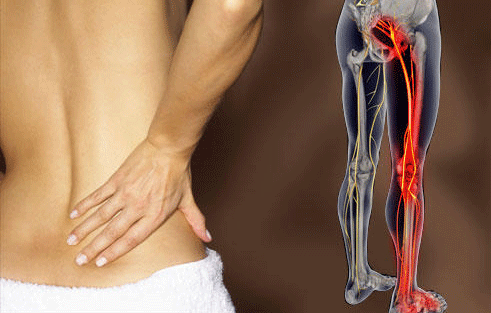 The sciatic nerve is the largest nerve in the body, which consists of a large bundle of smaller nerves that begin in the lumbar spine, travel down the buttocks, and move through the leg.
The sciatic nerve is the largest nerve in the body, which consists of a large bundle of smaller nerves that begin in the lumbar spine, travel down the buttocks, and move through the leg.
Technically, sciatica is not a disease, but a group of symptoms that affect the region of the sciatic nerve. Sciatica is not a conventional medical diagnosis. It has several possible causes and these may lead to different treatments, so we use the term sciatica to describe a set of symptoms.
Radiating pain is one of the more common and intense symptoms associated with sciatica. There can also be numbness and tingling starting in the lower back radiating down the leg. These may include back pain but there may be only hip, leg pain or even foot pain. Sometimes there is minimal pain and the patient mostly suffers from numbness or tingling, we call paresthesia. There may be leg weakness or coldness. The presentation is variable and usually happens only on one side. The pain may be described as aching, stabbing or burning.
Some of the more common causes of sciatica include the idea of the nerve getting pinched. Pressure can cause the nerve to become inflamed which causes the nerve to malfunction. The pressure may come near the spine where the nerves that feed the legs come from. It may occur in the hip joint or near the muscle known as piriformis. In most cases, inflammation encourages increased pressure by causing the tissues to swell.
How Does Chinese medicine view sciatica?
Chinese medicine states that the body is interconnected; no one part can be separated from another. The diagnosis and treatment is based upon identifying specific imbalances in the muscles and the body as a whole. Correcting the imbalance does not just treat the symptoms or mask the condition, but rather corrects the root of the problem by encouraging self-healing of the body. The most common imbalance in acute sciatica is qi and blood stagnation in the back channels. But it is also important to treat the underlying imbalance, which may be causing the qi and blood to stagnate.
How Does Acupuncture Treat Sciatica or Sciatic Nerve Inflammation?
Acupuncture can help reduce the pain of sciatica. There is substantial research to show that acupuncture is significantly better than no treatment and also at least as good, if not better than, standard medical care for back pain (Yuan 2008, Furlan 2008; see the Fact Sheet on Acupuncture and Back Pain).
The British Acupuncture Council says Acupuncture can help relieve back pain and sciatica by:
- Stimulating nerves located in muscles and other tissues, which leads to release of endorphins and other neurohumoral factors, and changes the processing of pain in the brain and spinal cord (Pomeranz 1987, Zhao 2008).
- Reducing inflammation, by promoting release of vascular and immunomodulatory factors (Kavoussi 2007, Zijlstra 2003).
- Improving muscle stiffness and joint mobility by increasing local microcirculation (Komori 2009), which aids dispersal of swelling.
- Causing a transient change in sciatic nerve blood flow, including circulation to the cauda equine and nerve root. This response is eliminated or attenuated by administration of atropine, indicating that it occurs mainly via cholinergic nerves (Inoue 2008).
- Influencing the neurotrophic factor signalling system, which is important in neuropathic pain (Dong 2006).
- Increasing levels of serotonin and noradrenaline, which can help reduce pain and speed nerve repair (Wang 2005).
- Improving the conductive parameters of the sciatic nerve (Zhang 2005).
- Promoting regeneration of the sciatic nerve (La 2005)
Once needles are inserted in certain acupuncture points, endorphin production will increase. Acupuncture can also cause muscle relaxation. Acupuncture will help to reprogram the muscles to stay relaxed. The back, hip, and pelvis are very interconnected and the treatment should incorporate all of them. Overall, the treatment should relax and stretch the tendons and fascia while strengthening the muscles. This will help release the spastic muscles and strengthen them, allowing the back to naturally heal. It can even encourage an out of place disc to go back into place, depending on severity.
After the pain is gone, it is important to maintain the healthy condition of the patient’s back. Stretching is essential and will help keep the muscles relaxed. Also, doing tai chi, the Chinese exercise and meditation, is very effective to strengthen the lower back and relax it.